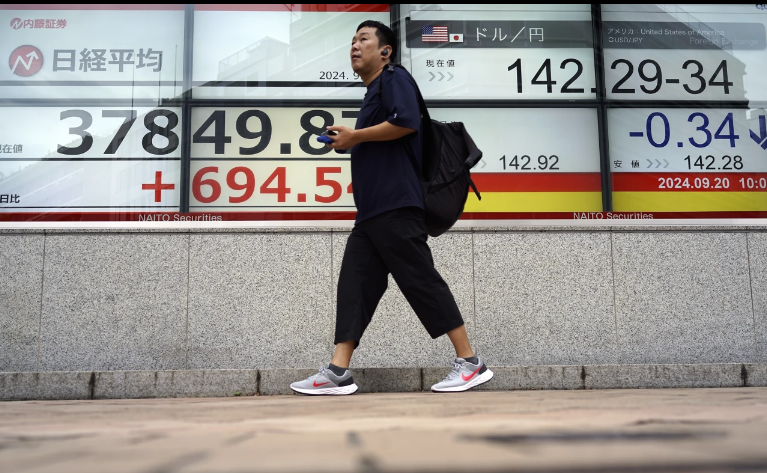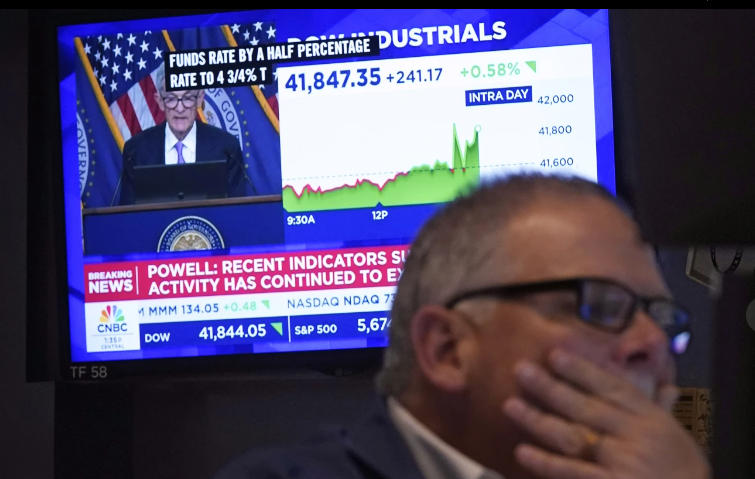 HONG KONG (AP) European markets traded lower on Friday after Asian stocks surged, as a rally driven by the Federal Reserve’s big cut to interest rates faded. Germany’s DAX lost 1.0% to 18,813.20 and the CAC 40 in Paris slipped 1.0%, to 7,540.71. In London, the FTSE 100 dropped 0.6% to 8,280.70. The future for the S&P 500 shed 0.2% and that for the Dow Jones Industrial Average was down less than 0.1%.
HONG KONG (AP) European markets traded lower on Friday after Asian stocks surged, as a rally driven by the Federal Reserve’s big cut to interest rates faded. Germany’s DAX lost 1.0% to 18,813.20 and the CAC 40 in Paris slipped 1.0%, to 7,540.71. In London, the FTSE 100 dropped 0.6% to 8,280.70. The future for the S&P 500 shed 0.2% and that for the Dow Jones Industrial Average was down less than 0.1%.
The Bank of Japan ended a two-day monetary policy meeting by announcing it would keep its benchmark rate unchanged at 0.25%. In Tokyo, the Nikkei 225 index soared 1.5% to close at 37,723.91 after the nation’s key inflation data in August accelerated for a fourth consecutive month. The core consumer price index rose 2.8% year-on-year in August, exceeding the central bank’s 2% target and leaving room for further rate hikes. Markets are closely watching for hints on the pace of future rate hikes from BOJ Gov. Kazuo Ueda.
The U.S. dollar rebounded against the Japanese currency, rising to 143.82 yen from 142.62 yen late Thursday. The euro rose to $1.1166 from $1.1161. China refrained from further monetary stimulus as the central bank left key lending rates unchanged on Friday. The 1-year loan prime rate (LPR), the benchmark for most corporate and household loans, stays at 3.45%, and the 5-year rate, a reference for property mortgages, was held at 3.85%. The Hang Seng in Hong Kong added 1.4% to 18,258.57 and the Shanghai Composite index edged up less than 0.1% to 2,736.81.
Elsewhere in the region, Australia’s S&P/ASX 200 rose 0.2% at 8,209.50. South Korea’s Kospi advanced 0.5% to 2,593.37. India’s Sensex gained 0.9% and Taiwan’s Taiex was up 0.5%.
 On Thursday, the S&P 500 jumped 1.7% to 5,713.64 for one of its best days of the year and topped its last all-time high set in July. The Dow leaped 1.3% to 42,025.19, and the Nasdaq composite led the market with a 2.5% spurt to 18,013.98. Wall Street’s gains followed rallies for markets across Europe and Asia after the Federal Reserve delivered its first cut to interest rates in more than four years on Wednesday.
On Thursday, the S&P 500 jumped 1.7% to 5,713.64 for one of its best days of the year and topped its last all-time high set in July. The Dow leaped 1.3% to 42,025.19, and the Nasdaq composite led the market with a 2.5% spurt to 18,013.98. Wall Street’s gains followed rallies for markets across Europe and Asia after the Federal Reserve delivered its first cut to interest rates in more than four years on Wednesday.
That closed the door on a run where the Fed kept its main interest rate at a two-decade high in hopes of slowing the U.S. economy enough to stamp out high inflation. Now that inflation has fallen from its peak two summers ago, Chair Jerome Powell said the Fed can focus more on keeping the job market solid and the economy out of a recession Wall Street’s initial reaction to Wednesday’s cut was a yawn. Markets had already run up for months on expectations for lower rates. Stocks edged lower after swinging a few times. The Fed is still under pressure because the job market and hiring have begun to slow under the weight of higher interest rates. Some critics say the central bank waited too long to cut rates and may have damaged the economy.

